MXA RETRO TEST: WE RIDE ANDREW SHORT’S 2011 WORKS KTM 350SXF
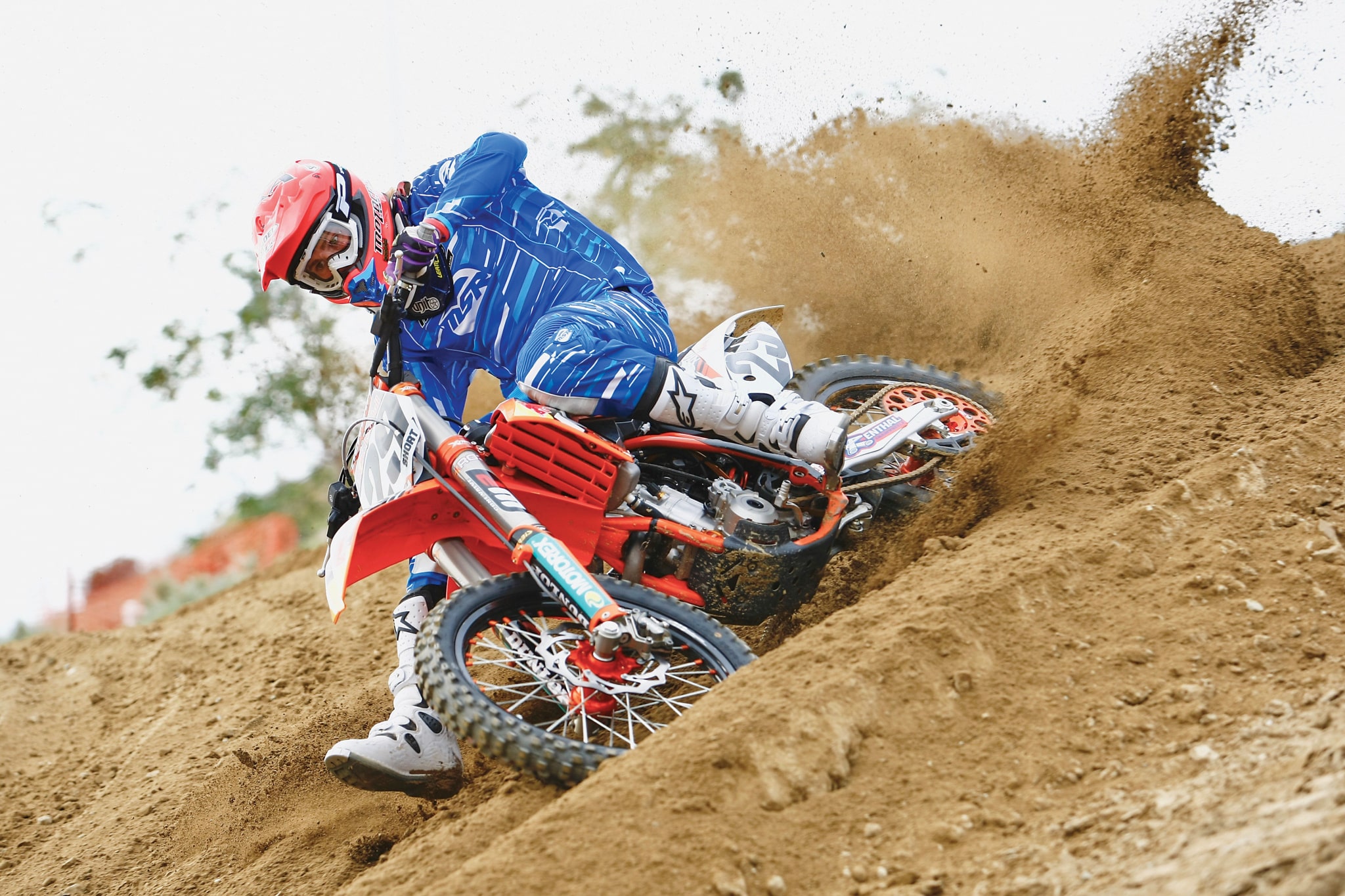
Perhaps no bike in recent history has engendered as much controversy, idle chatter and uninformed speculation as the KTM 350SXF. The mid-sized, Open-class bike is really not a rare bird in light of the spectrum of motocross history. Many of the iconic Open-class bikes raced over the years have been way below the maximum displacement. Included in this list of diminutive race bikes are the 360cc and 370cc machines used to great effect by Roger DeCoster during his heyday—the 360 Huskys of the Swedish ironmen, the 340cc Rokon Cobra automatic of Don Kudalski and, as recently as 13 years ago, the Yamaha YZ400 of 1998 AMA National Champion Doug Henry. So, what’s the buzz about?
THE MID-SIZED, OPEN-CLASS BIKE IS REALLY NOT A RARE BIRD IN LIGHT OF THE SPECTRUM OF MOTOCROSS HISTORY. MANY OF THE ICONIC OPEN-CLASS BIKES RACED OVER THE YEARS HAVE BEEN WAY BELOW THE MAXIMUM DISPLACEMENT. INCLUDED IN THIS LIST OF DIMINUTIVE RACE BIKES ARE THE 360CC AND 370CC MACHINES USED TO GREAT EFFECT BY ROGER DECOSTER DURING HIS HEYDAY
There are three reasons the KTM 350SXF is such a lightning rod for negative palaver:
(1) Ethnocentrism. There is a belief that Japanese motocross culture is inherently superior to any other. KTM is considered an outside force in American motocross. KTMs are regarded as strange, foreign, different and something to be feared. For certain subsets in our sport, if it isn’t made in Japan, it can’t be any good. Thus, a Honda CRF350 would be enthusiastically supported, but a KTM, Husqvarna or TM 350 would be subject to scorn.
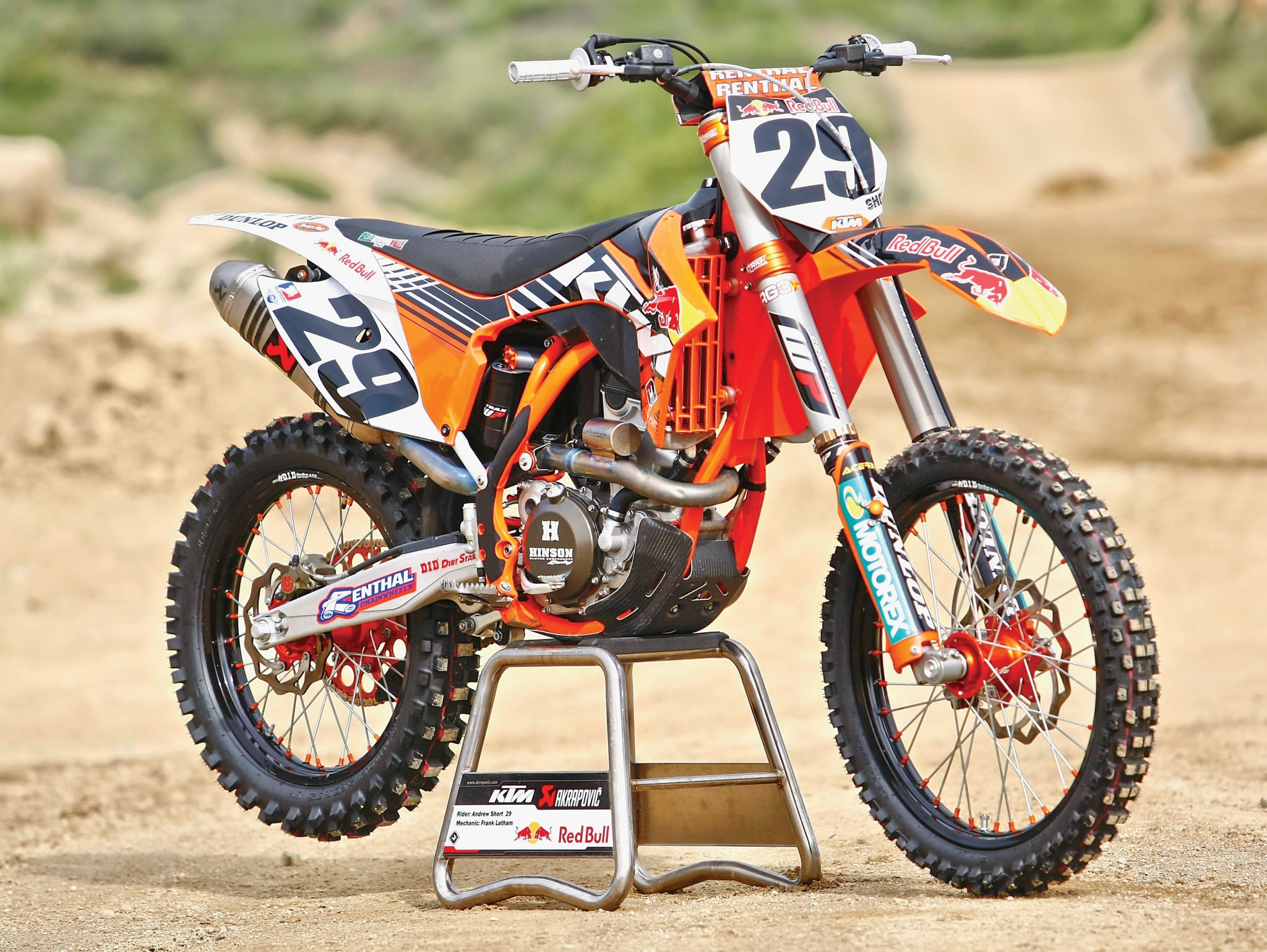
(2) Napoleon complex. No matter how many ways you slice it, the KTM 350SXF is smaller than its 450cc competition. To compensate for its smaller displacement, the 350SXF and its designers play off the obvious shortcomings with extra braggadocio. Thus, Antonio Cairoli doesn’t just win the World Championship, he does it on a smaller bike, stuck in one gear while eating gnocchi. The KTM 350SXF is thrown in the face of its critics with a cocky swagger by the Austrians.
(3) Panphobia. Most people who are invested heavily in the status quo have a persistent fear of the unknown. As with the atom-smashing Large Hadron Collider creating a black hole, a plume of radiation killing people on Myrtle Beach or the AMA making an intelligent decision, people fear what they don’t fully understand. Thus, if you ride a Japanese bike, you fear the success of European bikes because it could obsolete not only the machinery that you have invested in but also your tools, know-how, spare parts and sense of self.
But, motocross is not defined by -isms, phobias or complexes. Great sea changes have occurred despite the mob majority being heavily invested in existing technology. KTM wants to be part of the next great motocross migration, but even a quick glance at its history reveals that the Austrian firm is a niche marketer. They find holes in the product lines of the Japanese manufacturers and fill them. The mega manufacturers will never make a 150, 200, 300, 350, 400 or 520, so KTM hits them where they ain’t. The 350SXF is, from a marketing perspective, a hole filler. KTM’s success comes from being creative in the face of the global industrial might of its competition.

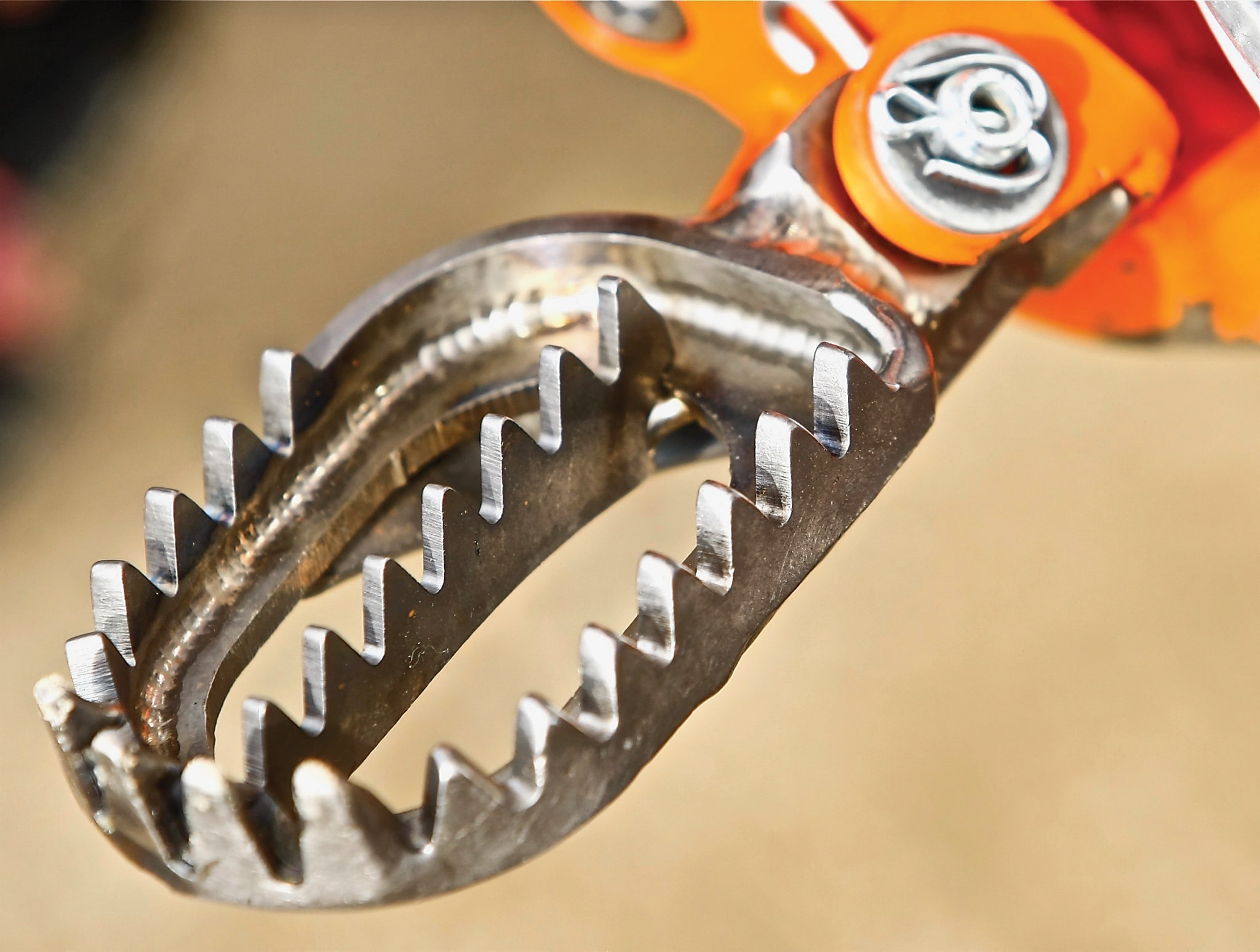
That puts the MXA wrecking crew and the factory KTM 350SXF of Andrew Short on a collision course. KTM doesn’t understand the public’s reluctance to give the 350SXF credit for what “the little bike that could” has done. Not only has it won the FIM 450 World Championship under Antonio Cairoli, it has, on occasion, put three bikes in the top 10 of an AMA 450 Supercross. What KTM needed was an outside source to test its race bike‚ a source that is known for being unbiased. That is how the MXA wrecking crew ended up with Andrew Short’s works KTM 350SXF.
KTM team manager Roger DeCoster wanted MXA to test the bike in the same way that an independent lab would test a toaster or a hairdryer. KTM gave us carte blanche in terms of access to the bike, mechanics, riders and riding time.
BUT, MOTOCROSS IS NOT DEFINED BY -ISMS, PHOBIAS OR COMPLEXES. GREAT SEA CHANGES HAVE OCCURRED DESPITE THE MOB MAJORITY BEING HEAVILY INVESTED IN EXISTING TECHNOLOGY.
DISCUSSING THE COMPONENTS
As the MXA wrecking crew circled Andrew Short’s KTM 350SXF, we peppered Roger DeCoster with a flurry of questions. “The Man” answered when he could, deferred to head technician Ian Harrison when he couldn’t and called the factory for more info when the questions went beyond common knowledge.
Engine base: The base of Andrew Short’s 350cc engine starts out as a production unit. It was obvious that the cases, castings, cylinder and head were all stock. We weren’t surprised by this, since when we tested Max Nagl’s Grand Prix 450SXF a few months ago, his engine used a plethora of off-the-shelf parts. Short’s bike uses the stock valves (from Del West), stock bore and stroke, and stock head (although ported). The cam timing has been changed (with the help of cams from the KTM factory), while the ignition is a stock KTM unit that has been reprogrammed. The exhaust system is from Akrapovic, but is different from the models they sell in the USA.

Piston and rod: When asked what the most exotic parts on Short’s bike were, Roger DeCoster said, “The Pankl rod and piston.” Pankl is an Austrian aerospace and F1 engineering company that makes high-end steel, titanium and aluminum alloy parts. They make pistons and rods for CP and Carillo for aftermarket use and special forged-aluminum parts for factory teams.
Transmission: We were surprised that Andrew runs the stock 5-speed transmission. Most factory-backed AMA Supercross and National bikes are outfitted with special British-made gearboxes with custom gear ratios (and, in fact, Max Nagl’s GP 450SXF had a works 4-speed tranny in place of the production 5-speed gearbox.
Clutch: Clutch action is handled by a stock Brembo hydraulic actuator that drives a Hinson unit (with an aluminum clutch basket in place of the stock steel basket).
Brakes/wheels/tires: Other than the works Brembo calipers, the KTM brakes weren’t oversized or overly massaged. The wheels were built up from Italian-made Kite hubs laced to D.I.D Dirt Star LTX rims. The tires were prototypes with a Dunlop D715 front (in a 90/90 size) and D767 rear tire (in a 120 size on harder tracks and a 110 on tacky dirt).
Frame: It is stock, as is the shock linkage.
Forks: The 52mm WP forks are all aluminum (other than the 0.48 fork springs). Short’s WP SXS forks were housed in 22mm-offset Xtrig triple clamps with solid-mounted bar mounts.
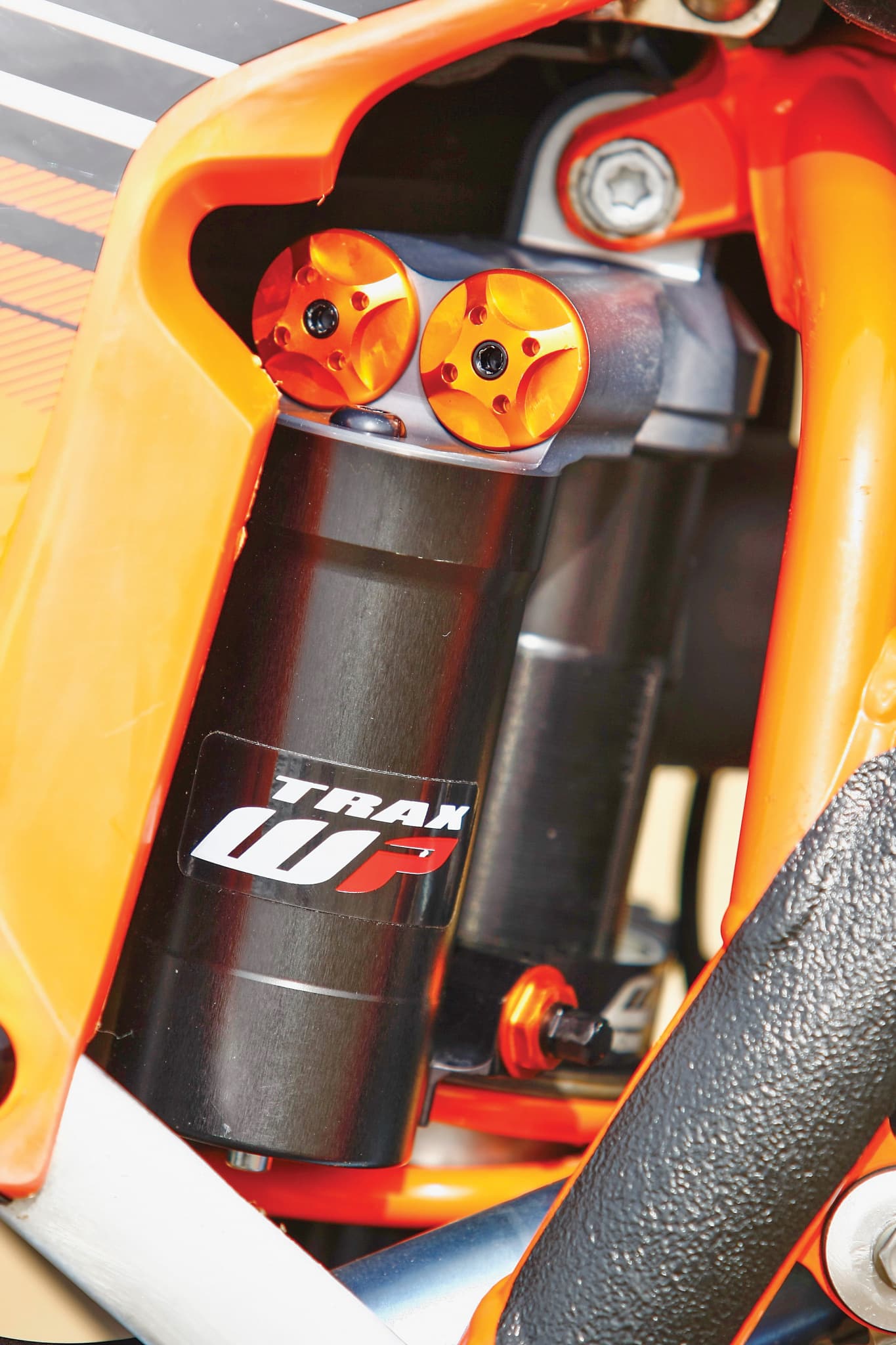
Shock: We expected Short’s bike to have an exotic shock linkage, but his 350SXF had a stock linkage. What was trick was his WP SXS Trax shock. It featured not only high- and low-speed adjusters but utilized WP’s unique dropout feature. What exactly is a dropout shock? Internally, the system is designed to speed up the rebound so the bike will settle faster and allow the rear tire to maintain better contact with the ground. As soon as the wheel leaves the ground, a valve opens to let the shock extend. It’s designed to work in small chop and braking bumps while compressing fully and allowing the spring to take the brunt of the impact over jumps and large hits. It was originally called a “dropout shock” because it provides negative travel to help the wheel follow the ground. The name was changed to “Trax” for marketing purposes. Short does not use the dropout feature in Supercross but does use it on his outdoor bike. The shock itself is 3mm shorter than the stocker, while the 5.7 N/mm rear spring is stiffer than stock. Spring preload is adjusted with an Xtrig worm-drive adjuster.
Miscellaneous: The list of aftermarket suppliers for Short’s bike isn’t as long as you would expect‚ since a lot of technical features are straight from the KTM factory. The lowered and rounded saddle is from Selle Dalla Valle (we will get to its trickest feature later). The battery for the electric starter is a full-spectrum Genesis battery that produces 125 cold cranking amps (CCA). Its best feature is its amazingly light weight. Short’s radiators are stockers, and his gearing varies from 13/51 for outdoors to 13/54 for Supercross.
KTM went to the trouble of molding a special one-off gas tank that uses the same shape, size and material of the stock gas tank, but has a threaded spout molded in to accept an old-school, screw-on-style gas cap instead of KTM’s quarter-turn gas cap. Inside the tank, KTM runs ETS race gas brewed to AMA specs.
GOING BIG ON SOMETHING SMALL
Four MXA test riders got to spend as much time as they desired on Short’s 350SXF. The test riders ranged from an AMA Pro to an intermediate, novice and vet. Shockingly, every test rider came in from his first test session and said that he felt that Short’s bike felt like a faster 350SXF, but it was nothing special. They liked the extra boost off the bottom, the stronger midrange and the longer pull on top, but none of them seemed overly impressed.
As each test rider cycled through the test protocol, he was given a hopped-up KTM 350SXF stocker for comparison. The stocker had the suspension done and the engine work performed by KTM’s in-house Factory Services hop-up program. When the riders climbed off the modified stocker, the first MXA test rider said, “Forget everything I said about Short’s engine the first time I rode it. Short’s bike is a rocket ship compared to this highly modified 350SXF. Each of the four test riders had the same comments. They varied from, “I underestimated the breadth of Short’s powerband,” to “No comparison. Short’s bike is twice as fast‚” to, “Holy mackerel.”
It was obvious that the KTM engineers and Andrew Short had spent a long time developing the powerband on his 350SXF. How do we know? Because Short’s powerband was totally refined. The hardest thing to do for a hopped-up engine is to keep all the usable traits of the stock powerband but make it better everywhere. The stock KTM (with the Factory Service engine) that we were comparing Short’s 350SXF against produced 50 horsepower. And, while KTM wouldn’t tell us how much horsepower Short’s bike made on their dyno, we guess that it was close to 54 horsepower. Rarely has a bike this fast felt this easy to ride. That is a major accomplishment, and credit goes to KTM’s engine builders, the race team mechanics and Andrew Short.
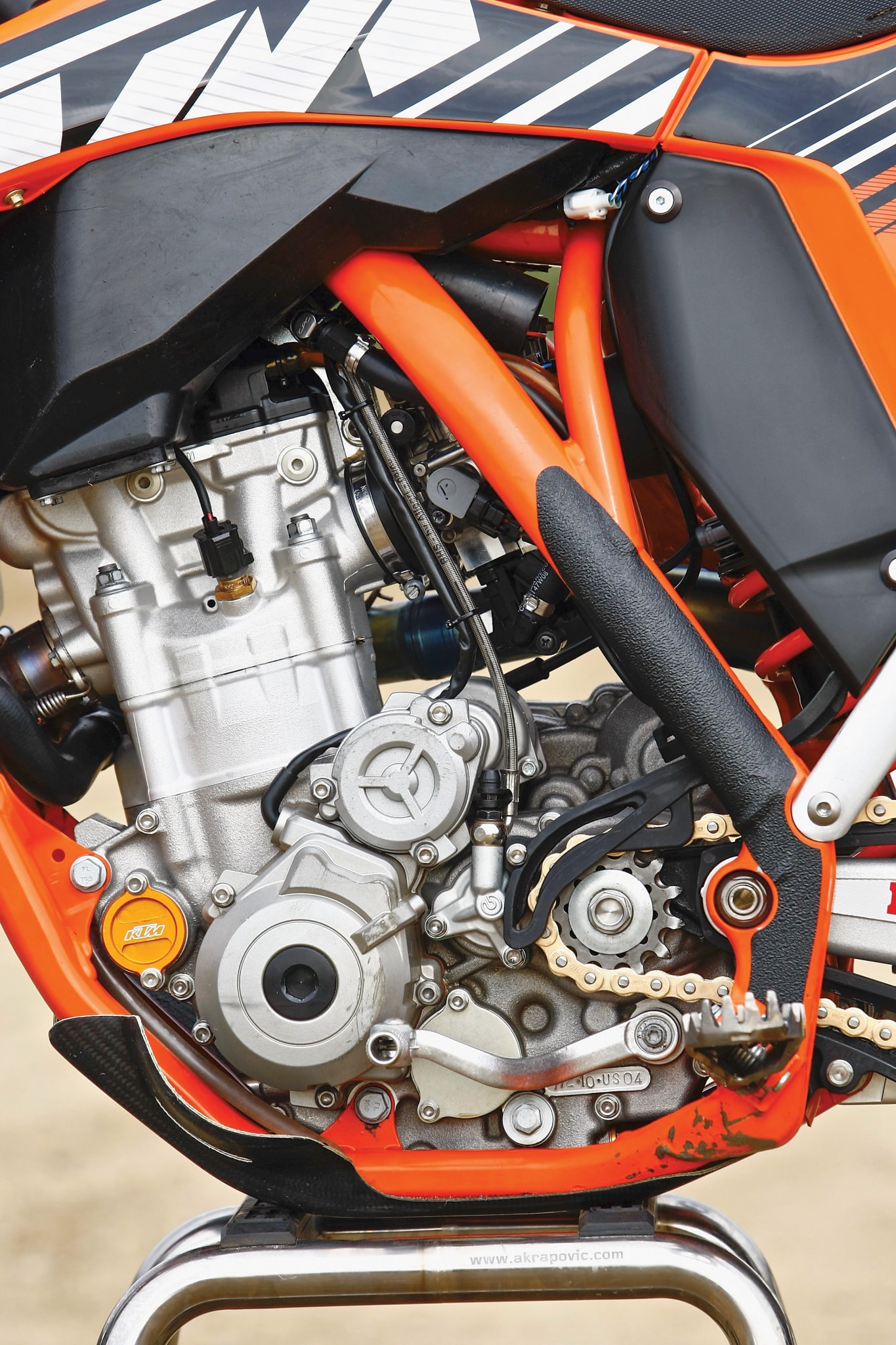
The coolest aspect of Short’s KTM was maintaining its light weight (while still retaining its electric starter). A stock 2011 KTM 350SXF weighs 237 pounds. Andrew Short’s 350SXF weighed 222.8 pounds. That is a 14-pound weight loss. How did they do it? One piece at a time. The Akrapovic pipe is 2 pounds lighter. The mix of titanium bolts (everything but the axles) and Ti footpegs knocks off a couple of pounds more. The Eibach steel shock spring saved 1 pound. The Selle Dalla Valle seat uses a special large-cell foam that has the consistency of air. It is the lightest seat that we have ever felt. The special full-spectrum battery weighs only 12 ounces (the stocker weighs 3 1/2 pounds). The Hinson aluminum clutch basket is a pound lighter than the stock steel KTM basket.
KTM could make Short’s bike even lighter by removing the electric starter and its wiring, gears and battery, but Ian Harrison said that when they tried that, Short’s bike came in under the AMA’s 220-pound weight limit.
“When I first signed on at KTM, I was most concerned about the handling, but I had no reason to be. The thing that surprised me the most was how well the 350SXF handled. My bike is set up very similar to the stocker,” said Andrew Short. And, he wasn’t kidding. Without any chassis mods and fairly compliant suspension (for an AMA Pro) Short’s bike was amazingly balanced, with the front being slightly softer than those of many works bike we have ridden (and 10 times softer than James Stewart’s front forks).
Short credits the powerband for the chassis’ good manners. He explained, “The balance is good, but I think a lot of that is a byproduct of the engine. It is much more stable than a 250 four-stroke but quicker than a 450. It feels very light, thanks to the smaller engine and lowered rotating mass. I never try to point and shoot like I did with my Honda CRF450; instead, I carry speed through the turns like on a 250.”
As for the power, Short’s bike is deceptively fast‚ but it never feels like a handful. The MXA test riders never felt the need to clutch the engine out of turns‚ which is something that we often do on both 250 and 450 four-strokes. We questioned Andrew about whether he had to use the clutch to keep the power percolating, and what he said surprised us: “I don’t use the clutch half as much as on a 450. On a 450, I mostly used the clutch to manage the power. I pulled it in coming into the turns, and I used it coming out of the turns to control the power, not magnify it. What I’ve discovered on the 350 is that I can use all the power that the engine has without trying to trick the power.”
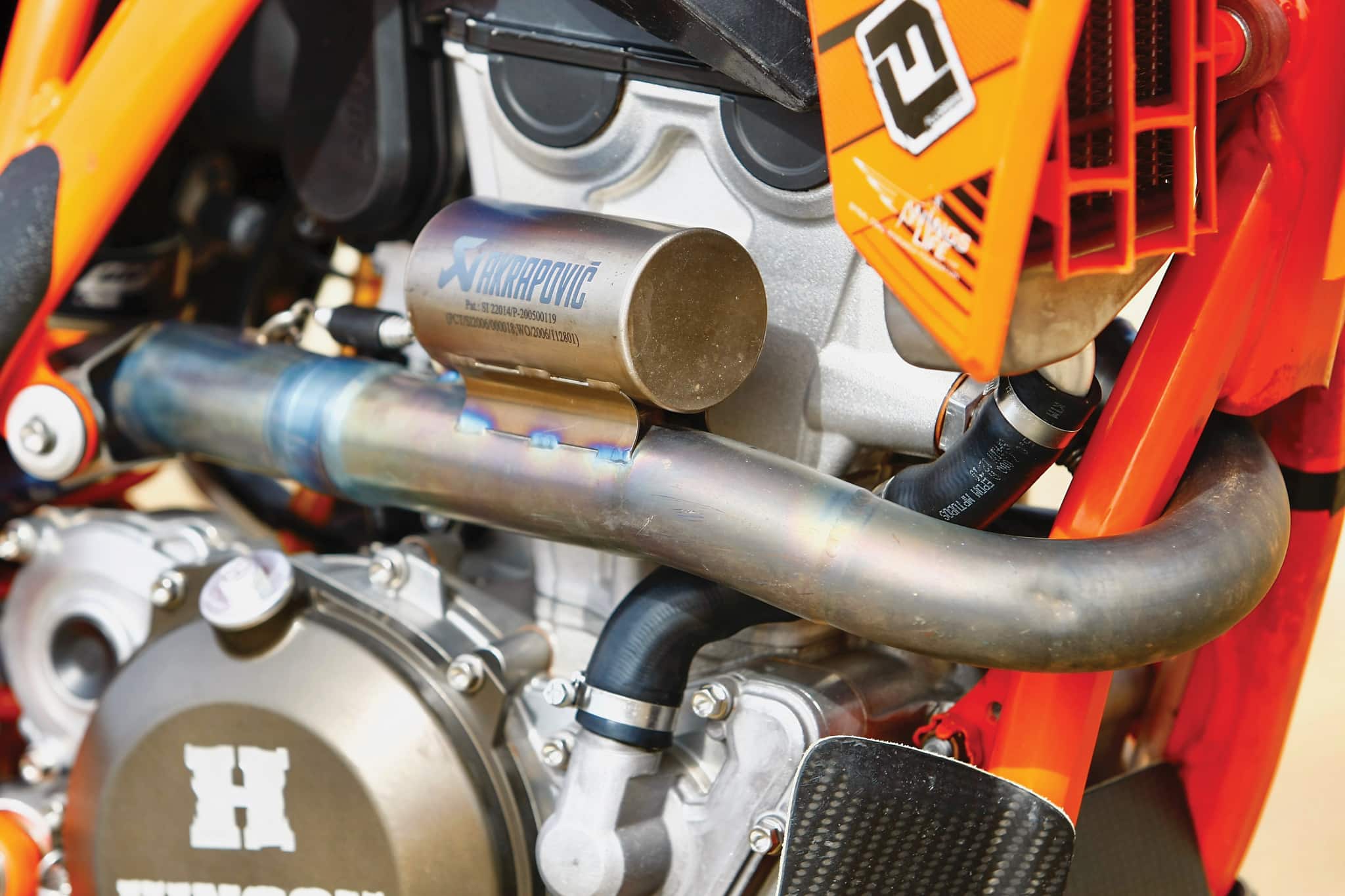
CONCLUSION: WHAT DO WE REALLY THINK?
Without pulling any punches, MXA never thought that KTM’s decision to race the 350SXF in Supercross was a good idea. Given the nature of most AMA Supercross tracks (and especially the idiotic design of most of the first turns), a Supercross is largely won in the first 50 feet. With equally talented riders, the guy with the most horsepower is going to get to the first turn first. When you start mid-pack, while Bubba, Skippy, Poto and Dungey are up front, you can only hope to be fifth at best‚ which is where Andrew Short has been finishing.
Outdoors is a horse of a different color. On longer starts, the reduced power of the 350cc engine can be offset by its extra 2,000 rpm of over-rev, which means that the 350 will go farther in each gear and can be revved into the corner. Additionally, with more room to maneuver, the light KTM 350SXF will be easier to ride late in the moto. We’d like our chances in a 35-minute moto on a 350‚ and we like Andrew Short’s chances even more.



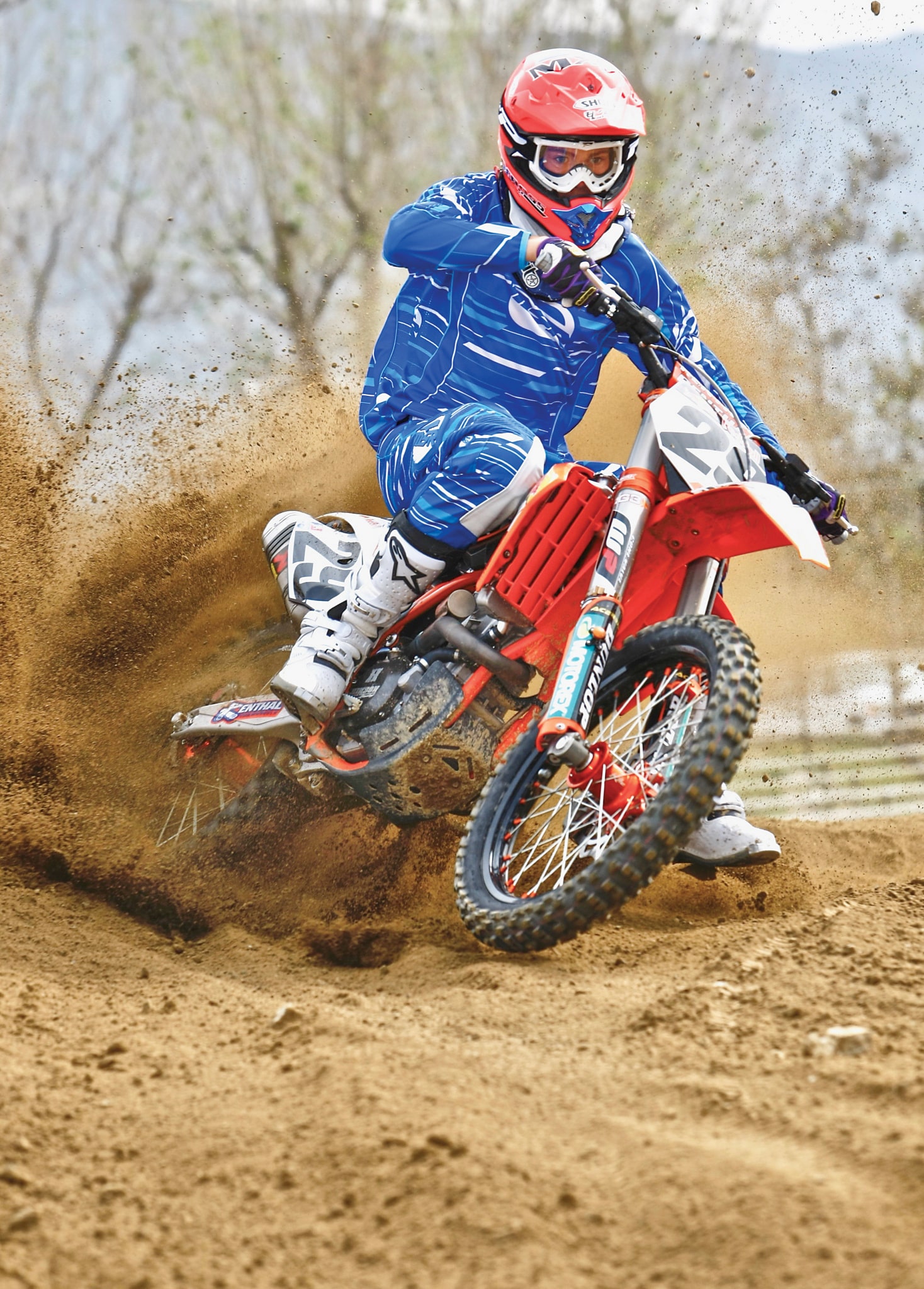




Comments are closed.